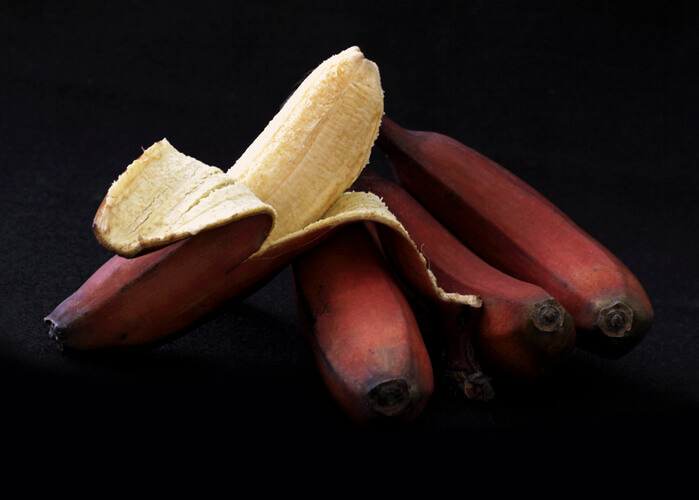Bananas Aren’t Always Yellow. Let’s Talk About Red Bananas
6 years ago | Nutrition
By Joy Stephenson-Laws, JD, Founder
If I asked you what color bananas are, you’d probably look at me like I’m crazy and say, “yellow.”
Obviously the majority of bananas, the world’s most popular fruit, we come across are yellow. I’ve previously blogged about the benefits of green bananas (basically bananas that have not ripened enough to turn yellow), but what you may not know is that there are actually red bananas (also known as Red Dacca bananas). The peel is red, but the flesh is still the color of your “everyday yellow” banana. Red bananas are also smaller in size.
Reportedly, more than 99 percent of the bananas consumed in the United States are the yellow Cavendish bananas. However, in other parts of the world, particularly Central America and Southeast Asia, you may be more likely to come across red bananas.
I recently discovered these red bananas myself. And when I did, I became quite curious about them.
There are actually so many different types of bananas, it’s bananas!
Bananas grow in more than 150 countries, and there are believed to be more than 1,000 types of bananas in the world. As mentioned, the most common are the yellow Cavendish, however, there are some other more rare varieties (aside from the red). For example, there is the Blue Java, also known as the Ice Cream banana. This rare banana is said to be sweet and creamy and has a taste similar to vanilla ice cream!
Now, back to red bananas.
Red bananas have a unique flavor, similar to yellow, but mixed with the taste of raspberries. They also provide more health benefits than the widely recognized, traditional banana,” according to this Medical Daily report.
In my opinion, it really depends on the needs of the person eating the banana as far as whether one color banana is healthier than the other. For example, green bananas may be great for people with diabetes and people who need to be mindful of their blood sugar, because green bananas contain less sugar than fully ripe bananas.
Red bananas taste sweeter than yellow ones, because they contain more sugar and calories than yellow bananas. A registered dietician referenced in the Medical Daily report says that a red banana will have about 30 more calories and eight more grams of sugar than a yellow one of the same size. So red bananas may not be the best banana option for someone who is prediabetic or diabetic or someone who is trying to watch their caloric intake.
But what’s mind blowing to me is that despite being sweeter, red bananas actually have a lower glycemic index than yellow bananas.
“The reason red bananas can have slightly more sugar, with a slightly lower glycemic index, is because of their amylose/amylopectin ratio. That is the ratio of resistant starch to that which is easily digested. High amounts of amylose lead to a slower absorption of the sugars,” according to this report.
So in this sense, red bananas may be better for someone who has to watch their blood sugar. Every individual is different, and we always advise seeking the advice of a competent healthcare professional regarding what foods to include in your daily diet.
Red bananas also contain more of certain nutrients than yellow bananas.
- Red bananas are more rich in vitamin C.
Reportedly, a 99 gram red banana contains 15 percent of the recommended daily allowance of vitamin C.
Vitamin C is one of the most important nutrients needed for survival. This nutrient protects the immune system from deficiencies that may lead to cardiovascular illnesses and other diseases. It is also an antioxidant, which means it protects our bodies from free radicals and other harmful molecules. It is a major producer of collagen, which is the main ingredient behind the repair of bone and skin tissue, cartilage, ligaments, tendons and teeth. Vitamin C also helps moisturize and nourish the skin, which may increase skin elasticity and may even restore a youthful appearance.
- Red bananas are more rich in beta-carotene, which our bodies convert to vitamin A.
This vitamin is a great anti-ager and helps reduce the appearance of fine lines and wrinkles. Vitamin A also helps protect your vision.
“Through its role with cell growth and division, vitamin A has an important role in the normal formation and maintenance of the heart, lungs, kidneys and other vital organs,” says a doctor in one report.
- Red bananas are more rich in some antioxidants.
In addition to the antioxidant vitamin C, red bananas are especially rich in the following antioxidants: carotenoids, anthocyanins and dopamine. Antioxidants fight free radical damage and may help prevent all types of diseases, including cancer and dementia. They are also great anti-agers.
And just like yellow bananas, red bananas are rich in other essential nutrients including potassium, magnesium, fiber (particularly prebiotic fiber) and vitamin B6.
Where can you find red bananas?
Red bananas are available all year, and you may find them at your local specialty market. These red gems are not always easy to come by in the United States, so you may have to enlist the help of a specialty produce app to help you locate and order them.
Have you ever had a red banana or any other type of banana other than a yellow one? Please join the conversation and share.
Enjoy your healthy life!
The pH professional health care team includes recognized experts from a variety of health care and related disciplines, including physicians, attorneys, nutritionists, nurses and certified fitness instructors. This team also includes the members of the pH Medical Advisory Board, which constantly monitors all pH programs, products and services. To learn more about the pH Medical Advisory Board, click here.







